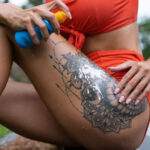So, you’ve just gotten a fresh piece of ink and the burning question is: Can I Wash My Tattoo With Cold Water? Absolutely, and it’s actually recommended! At tattooat.com, we understand the importance of proper tattoo aftercare to ensure your body art remains vibrant and healthy for years to come. Using cold water is a great start to maintain the quality, shading, and durability of your new tattoo.
1. What Happens If I Wash My Tattoo With Cold Water?
Washing your tattoo with cold water is generally safe and beneficial. Cold water helps to close the pores, reducing ink leakage and minimizing inflammation. This promotes faster healing and helps maintain the vibrancy of your tattoo.
Immediately rinsing your new tattoo with cold water offers several advantages:
- Reduces Bleeding: Cold water constricts blood vessels, minimizing bleeding at the tattoo site.
- Minimizes Swelling: It helps reduce swelling and inflammation, contributing to a more comfortable healing process.
- Closes Pores: Cold water assists in closing pores, preventing excessive ink leakage and promoting better ink retention.
- Soothes Irritation: It can soothe any irritation or itching sensations, providing relief during the initial healing phase.
 Fresh tattoo on arm being gently washed with cold water. The background shows a clean bathroom setting, emphasizing hygiene and aftercare.
Fresh tattoo on arm being gently washed with cold water. The background shows a clean bathroom setting, emphasizing hygiene and aftercare.
2. Can I Wash My Tattoo With Cold Water? The Initial Wash
Yes, you can wash your tattoo with cold water. Generally, tattoo artists will bandage the new tattoo and instruct you to wait for a specific period, usually between 3 to 24 hours, before removing the bandage. Once you remove the bandage, gently wash the tattoo with antibacterial, fragrance-free soap and cold or lukewarm water.
Here’s a step-by-step guide:
- Wash Your Hands: Always start with clean hands to prevent infection.
- Use Mild Soap: Apply a small amount of fragrance-free, antibacterial soap to your fingertips.
- Gently Wash: Gently cleanse the tattooed area with the soapy water, using circular motions.
- Rinse Thoroughly: Rinse the tattoo with cold water until all soap residue is removed.
- Pat Dry: Pat the area dry with a clean, soft paper towel. Avoid rubbing, as this can irritate the skin.
- Moisturize: Apply a thin layer of tattoo-specific moisturizer to keep the skin hydrated.
3. Why Is Cold Water Preferred Over Hot Water for Tattoo Aftercare?
Cold water is preferred over hot water because it helps to close the pores and reduce inflammation, minimizing ink loss. Hot water, on the other hand, opens the pores, which can cause the ink to leach out and increase the risk of fading or blurring. According to Portland State University’s Art Department, in July 2025, cold water is proven to provide optimal results for new tattoo aftercare.
Here is a detailed comparison of cold vs. hot water:
| Feature | Cold Water | Hot Water |
|---|---|---|
| Pore Action | Closes pores, reducing ink leakage | Opens pores, increasing ink leakage |
| Inflammation | Reduces inflammation and swelling | May increase inflammation and swelling |
| Blood Vessels | Constricts blood vessels, minimizing bleeding | Dilates blood vessels, potentially increasing bleeding |
| Ink Retention | Promotes better ink retention, preserving vibrancy | May cause ink to leach out, leading to fading or blurring |
| Comfort | Soothes irritation and provides relief | Can cause discomfort and irritation due to increased sensitivity |
| Risk of Infection | Minimizes risk of infection by keeping pores closed and preventing bacteria from entering | May increase risk of infection by opening pores and allowing bacteria to enter more easily |
4. What Kind of Soap Should I Use?
Use a mild, fragrance-free, antibacterial soap. Avoid soaps with harsh chemicals, alcohol, or strong fragrances, as these can irritate the skin and affect the tattoo ink. Some recommended soaps include:
- Dial Gold Antibacterial Soap: A classic choice known for its gentle yet effective cleansing properties.
- Cetaphil Gentle Skin Cleanser: A non-irritating formula that’s perfect for sensitive skin.
- Dr. Bronner’s Pure-Castile Liquid Soap (Baby Unscented): A versatile, all-natural option that’s free from harsh chemicals.
5. How Often Should I Wash My New Tattoo?
Wash your new tattoo twice a day, typically in the morning and before bed. Over-washing can dry out the skin, while under-washing can lead to infection. Finding the right balance is key to promoting optimal healing.
A suggested washing routine:
- Morning: Wash your tattoo in the morning to remove any overnight buildup of bacteria or fluids.
- Evening: Wash again before bed to ensure the area is clean before you sleep.
- After Sweating: If you engage in physical activity or sweat heavily, wash your tattoo immediately afterward to prevent infection.
6. What Happens If I Don’t Wash My Tattoo?
Not washing your tattoo can lead to several complications. A build-up of bacteria can cause infections, leading to redness, swelling, pain, and even pus formation. Additionally, dead skin cells and excess ink can accumulate, hindering the healing process and affecting the appearance of the tattoo.
Potential consequences of not washing your tattoo include:
- Infection: Bacteria can thrive on the skin, leading to infections that require medical treatment.
- Delayed Healing: Dead skin cells and debris can prevent the skin from healing properly, prolonging the recovery period.
- Ink Fading: Accumulated substances can interfere with ink settling into the skin, causing fading or uneven coloration.
- Scarring: In severe cases, infections can lead to scarring, which can distort the appearance of the tattoo.
 Close-up of a clean tattoo after washing, showcasing vibrant colors and clear lines. The image emphasizes the importance of hygiene in tattoo aftercare.
Close-up of a clean tattoo after washing, showcasing vibrant colors and clear lines. The image emphasizes the importance of hygiene in tattoo aftercare.
7. Can I Use Saniderm and Still Wash My Tattoo With Cold Water?
Yes, you can use Saniderm, a medical-grade, waterproof bandage, and still wash your tattoo with cold water. Saniderm protects the tattoo from bacteria and allows it to heal in a moist environment. If your tattoo artist applied Saniderm, you can shower without worry, but it’s still wise to keep the tattoo out of the direct flow of water.
Here’s how to manage washing with Saniderm:
- Check the Seal: Ensure the Saniderm bandage is securely sealed around the tattoo.
- Gentle Washing: Gently rinse the area with cold water and mild soap.
- Avoid Direct Pressure: Avoid directing high-pressure water directly onto the bandage.
- Pat Dry: After showering, pat the area dry with a clean towel.
- Monitor for Issues: Keep an eye out for any signs of leakage, irritation, or fluid buildup under the bandage.
8. Can I Shower Normally After Getting a Tattoo?
You can shower normally 3-4 hours after getting a tattoo if you have a Saniderm bandage. If you have a plastic wrap, wait 24 hours to unwrap your tattoo and shower. In either case, use cold or lukewarm water and avoid prolonged soaking for 3-4 weeks.
Key considerations for showering after getting a tattoo:
- Water Temperature: Always use cold or lukewarm water.
- Duration: Keep showers short to minimize water exposure.
- Direct Water Flow: Avoid direct water flow on the tattoo.
- Soap: Use mild, fragrance-free antibacterial soap.
- Moisturize: Apply a thin layer of tattoo-specific moisturizer afterward.
9. What Are The Best Practices For Drying My Tattoo After Washing It With Cold Water?
After washing your tattoo with cold water, gently pat the area dry with a clean, soft paper towel. Avoid using a regular towel, as it may harbor bacteria and can be too abrasive for the sensitive skin. Make sure the area is completely dry before applying any moisturizer.
Best practices for drying your tattoo:
- Use Paper Towels: Opt for clean, disposable paper towels instead of cloth towels.
- Gentle Patting: Pat the area dry gently, avoiding rubbing or harsh motions.
- Ensure Complete Dryness: Make sure the area is completely dry before applying moisturizer or clothing.
- Avoid Air Drying: Don’t let the tattoo air dry, as this can lead to excessive dryness and cracking.
 Tattoo being dried gently with a paper towel after washing. The image illustrates proper drying techniques to avoid irritation and promote healing.
Tattoo being dried gently with a paper towel after washing. The image illustrates proper drying techniques to avoid irritation and promote healing.
10. What Activities Should I Avoid After Getting a Tattoo?
Avoid activities that can expose your new tattoo to bacteria, excessive moisture, or direct sunlight. This includes swimming, soaking in baths, using saunas, and prolonged sun exposure. It’s also essential to avoid wearing tight clothing that can rub against the tattoo and cause irritation.
Activities to avoid:
- Swimming: Avoid pools, oceans, and hot tubs for at least 3-4 weeks.
- Baths: Do not soak in a bathtub until the tattoo is fully healed.
- Saunas: Stay away from saunas and steam rooms.
- Direct Sunlight: Protect your tattoo from prolonged sun exposure.
- Tight Clothing: Wear loose, breathable clothing to prevent friction.
- Excessive Sweating: Minimize activities that cause excessive sweating.
11. How Long After a Tattoo Can You Take a Bath?
Do not take a bath and fully submerge your tattoo for 3-4 weeks after getting a tattoo. The larger the tattoo, the longer you should wait. Never submerge a new tattoo in water for any length of time directly following the procedure. Recovery depends on factors like size, placement, and your immune system. If your tattoo isn’t fully healed, don’t soak it, to avoid risking infection or disfiguration.
12. How Long After a Tattoo Can You Swim?
Wait 3-4 weeks to swim after getting a tattoo. Submerging your tattoo in water risks irritation and bacterial infection. Swimming is even more destructive than bathing because of chlorine or salt water. You need to avoid soaking or submerging your tattoo as much as possible until it’s fully healed.
13. Will Soaking a New Tattoo Fade It?
Yes, soaking your tattoo immediately after getting it may cause it to fade more quickly. Soaking can cause infection, flaking, itching, and scabbing. After waiting a month for healing, you can soak your new tattoo in a bath or swimming pool without causing the ink to fade.
 An illustrative image showcasing a person refraining from swimming in a pool to protect their new tattoo. The scene emphasizes caution and proper aftercare.
An illustrative image showcasing a person refraining from swimming in a pool to protect their new tattoo. The scene emphasizes caution and proper aftercare.
14. How Long After a Tattoo Can You Wash It With Soap?
Though you can rinse your new tattoo within 3-4 hours, it’s best to wait 24 hours to gently wash it with hypoallergenic soap. Follow your tattoo artist’s instructions for when to apply soap, as in many cases, if your tattoo is wrapped with Saniderm, you may keep the healing bandage on for 3-4 days before removing it to wash with unscented antibacterial soap.
Avoid using soaps with alcohol, as they will cause your skin to dry out and may affect the ink. Use warm-to-cold water, hypoallergenic soap, and your fingers to clean your tattoo during the early stages of healing. You may notice your tattoo is a little weepy, which means there is some ink coming out of the tattoo. This is completely normal and lasts for about a week.
Avoid using anything abrasive such as loofahs and washcloths, as these will prolong your tattoo’s healing process and may harbor harmful, infection-causing bacteria.
15. What Are Some Signs of Tattoo Infection I Should Look Out For?
Keep an eye out for signs of infection, such as:
- Excessive Redness: Some redness is normal, but excessive redness could indicate an infection.
- Swelling: Significant swelling around the tattoo area is a cause for concern.
- Pain: Increasing pain or throbbing sensations should be monitored.
- Pus: Any discharge of pus from the tattoo is a clear sign of infection.
- Fever: If you develop a fever, seek medical attention immediately.
If you notice any of these signs, consult a healthcare professional or your tattoo artist promptly.
16. How Does the Location of the Tattoo Affect Washing and Aftercare?
The location of your tattoo can influence how you wash and care for it. Areas that are prone to friction or moisture, such as underarms or groin, may require more frequent cleaning. Tattoos on joints, like elbows or knees, need extra moisturizing to prevent cracking.
Specific considerations for different tattoo locations:
- Underarms: Clean gently to avoid irritation from deodorants.
- Groin: Keep the area dry and clean to prevent bacterial growth.
- Joints: Moisturize regularly to maintain skin elasticity.
- Feet: Avoid wearing tight shoes that can rub against the tattoo.
- Back: Enlist help from someone to ensure thorough cleaning.
17. Can I Use a Loofah or Washcloth to Wash My Tattoo?
No, avoid using a loofah or washcloth to wash your new tattoo. These items can be too abrasive and may harbor bacteria that can cause infection. Instead, use your clean fingertips to gently cleanse the area.
Why avoid loofahs and washcloths:
- Abrasiveness: They can irritate the sensitive skin and disrupt the healing process.
- Bacteria: They can harbor bacteria, increasing the risk of infection.
- Fiber Shedding: Fibers can get trapped in the tattoo and cause irritation.
18. How Important Is Moisturizing After Washing My Tattoo With Cold Water?
Moisturizing is crucial after washing your tattoo with cold water. It keeps the skin hydrated, promotes healing, and prevents scabbing. Use a tattoo-specific moisturizer or a fragrance-free, hypoallergenic lotion.
Benefits of moisturizing:
- Hydration: Keeps the skin hydrated and supple.
- Healing: Promotes faster healing and reduces inflammation.
- Scab Prevention: Prevents excessive scabbing, which can damage the tattoo.
- Ink Preservation: Helps maintain the vibrancy and clarity of the ink.
19. What Are Some Recommended Tattoo Moisturizers?
- Aquaphor Healing Ointment: A classic choice for tattoo aftercare, known for its healing and moisturizing properties.
- Eucerin Advanced Repair Lotion: A fragrance-free lotion that’s perfect for sensitive skin.
- Hustle Butter Deluxe: A popular tattoo balm made with natural ingredients.
20. How Long Will It Take for My Tattoo to Fully Heal?
A tattoo typically takes about 2-4 weeks to heal completely, but this can vary depending on the size, location, and your body’s healing ability. Follow your tattoo artist’s aftercare instructions carefully to ensure proper healing and prevent complications.
Factors affecting healing time:
- Tattoo Size: Larger tattoos may take longer to heal.
- Tattoo Location: Areas with more friction may take longer to heal.
- Individual Healing Ability: Some people heal faster than others.
- Aftercare Compliance: Following aftercare instructions is crucial for optimal healing.
21. What Should I Do If My Tattoo Is Itchy?
Itching is a common side effect of the healing process. Avoid scratching the tattoo, as this can damage the skin and increase the risk of infection. Instead, gently pat the area or apply a thin layer of moisturizer to relieve the itch.
Tips for managing itching:
- Avoid Scratching: Resist the urge to scratch the tattoo.
- Gentle Patting: Gently pat the area to relieve itching.
- Apply Moisturizer: Keep the skin hydrated with a thin layer of moisturizer.
- Cold Compress: Apply a cold compress to soothe the area.
22. Can I Exercise After Getting a Tattoo?
Avoid intense exercise for the first few days after getting a tattoo, as sweating can increase the risk of infection. If you do exercise, wear loose clothing and wash the tattoo immediately afterward.
Precautions for exercising:
- Avoid Intense Workouts: Limit strenuous activities for the first few days.
- Wear Loose Clothing: Choose breathable, loose-fitting clothing to minimize friction.
- Wash Immediately: Clean the tattoo thoroughly after exercising.
- Stay Hydrated: Drink plenty of water to keep the skin hydrated.
23. How Does Sun Exposure Affect a New Tattoo?
Sun exposure can cause the ink to fade and damage the skin, so it’s important to protect your new tattoo from the sun. Apply a high SPF sunscreen specifically designed for tattoos, or wear loose clothing to cover the area.
Protection from sun exposure:
- Apply Sunscreen: Use a tattoo-specific sunscreen with high SPF.
- Wear Loose Clothing: Cover the tattoo with loose, breathable clothing.
- Avoid Peak Hours: Limit sun exposure during peak hours (10 AM – 4 PM).
- Stay in the Shade: Seek shade whenever possible.
24. What Are the Key Takeaways For Tattoo Aftercare and Washing With Cold Water?
Key Takeaways for Effective Tattoo Aftercare:
- Wash with Cold Water: Use cold water for initial and regular cleaning to minimize ink loss and inflammation.
- Use Antibacterial Soap: Choose a mild, fragrance-free antibacterial soap to prevent infection.
- Pat Dry with Paper Towels: Gently pat the area dry with clean paper towels to avoid irritation.
- Moisturize Regularly: Keep the skin hydrated with a tattoo-specific or hypoallergenic moisturizer.
- Avoid Soaking and Swimming: Refrain from soaking in baths or swimming for at least 3-4 weeks.
- Protect from Sun Exposure: Shield the tattoo from direct sunlight to prevent fading.
- Avoid Abrasive Materials: Steer clear of loofahs and washcloths that can irritate the skin.
- Stay Hydrated: Drink plenty of water to promote skin health and healing.
25. Are There Any University Studies That Support the Importance of Washing a Tattoo With Cold Water?
While specific university studies directly focusing on washing tattoos with cold water may be limited, research in dermatology and wound care supports the principles behind this practice. Studies often highlight the benefits of cold compresses and cold water in reducing inflammation, constricting blood vessels, and minimizing swelling in acute injuries and skin irritations. These mechanisms are beneficial in tattoo aftercare to reduce ink loss and promote faster healing.
FAQ About Washing Tattoos With Cold Water
1. Is it OK to wash my tattoo with cold water?
Yes, it is generally recommended to wash your new tattoo with cold or lukewarm water to help close the pores and reduce inflammation.
2. Can I use ice water to wash my tattoo?
While cold water is good, avoid using ice water directly on your tattoo, as extreme temperatures can shock the skin and hinder the healing process.
3. How soon after getting a tattoo can I wash it?
Wait for the period recommended by your tattoo artist, usually 3-24 hours after getting your tattoo. Remove the bandage and gently wash the tattoo with antibacterial soap and cold water.
4. What happens if I use hot water to wash my tattoo?
Hot water can open the pores, causing ink to leach out and increasing the risk of fading or blurring. It may also increase inflammation.
5. How often should I moisturize my tattoo after washing?
Moisturize your tattoo after each washing, typically 2-3 times a day, or whenever the skin feels dry.
6. Can I use regular soap to wash my tattoo?
Avoid using regular soaps with harsh chemicals, alcohol, or strong fragrances. Stick to mild, fragrance-free antibacterial soap.
7. Is it normal for my tattoo to bleed when I wash it?
Some minimal bleeding is normal during the first few washes. However, excessive bleeding should be reported to your tattoo artist or a healthcare professional.
8. Can I use a washcloth to dry my tattoo?
No, avoid using a washcloth, as it may harbor bacteria. Use a clean, soft paper towel to pat the area dry.
9. What are the best lotions to use on a new tattoo?
Recommended lotions include Aquaphor Healing Ointment, Eucerin Advanced Repair Lotion, and Hustle Butter Deluxe.
10. How do I know if my tattoo is healing properly?
Signs of proper healing include minimal redness, no excessive swelling, and the formation of thin, even scabs. If you notice signs of infection, consult a healthcare professional.
At tattooat.com, we’re dedicated to providing you with the best information and resources for all your tattoo needs. From design inspiration to aftercare tips, we’ve got you covered. Explore our extensive collection of tattoo designs, discover talented artists, and dive into our in-depth articles to ensure your tattoo journey is a success.
Ready to find your next tattoo design or locate a top-notch artist? Visit tattooat.com today and let us help you bring your vision to life!
Address: 1825 SW Broadway, Portland, OR 97201, United States
Phone: +1 (503) 725-3000
Website: tattooat.com
